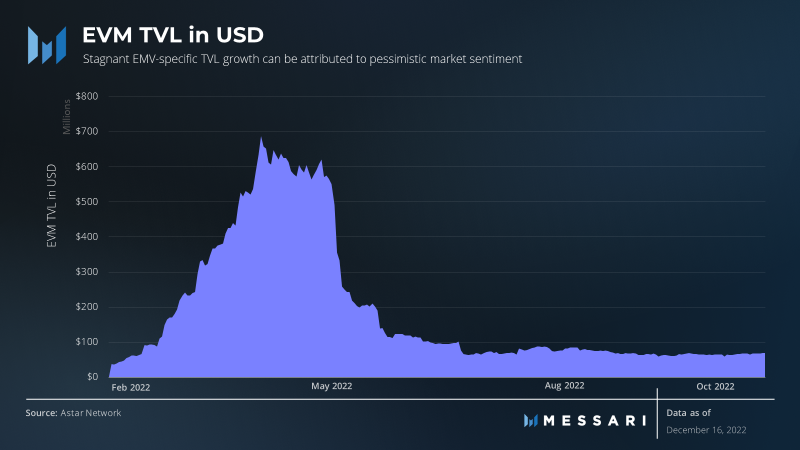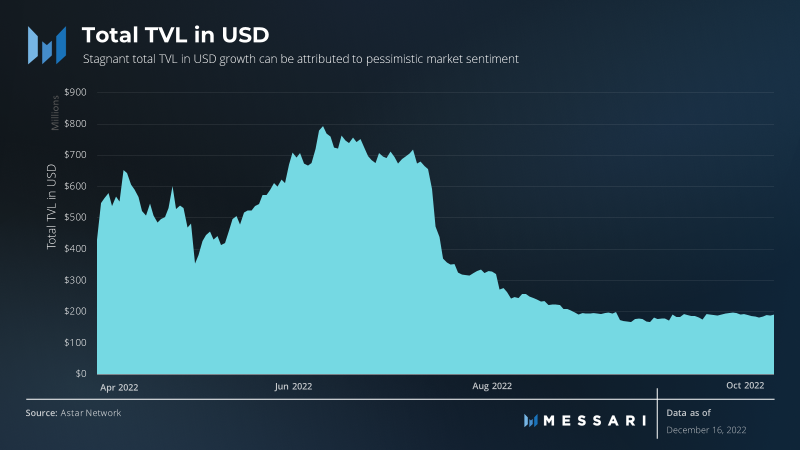Insights
- Astar is one of the most used parachains in the Polkadot network as a Layer-1 blockchain enabling interactions between EVM and WASM environments.
- Astar has two core offerings: the Cross-Virtual Machine and the dapp Staking mechanism which allows developers that built on Astar to earn block rewards.
What is the Astar Network?
Imagine driving down a bridge connecting two islands that speak separate languages. At the halfway point, you come across a city on the bridge itself. Realizing that you need to refuel, you drive into the city and learn that the people living there speak the languages of both islands. The city has more than just a gas station, and it is more of a thriving metropolis with grocery stores, banks, multi-family apartment complexes, and more. You’re a bit confused because why would anyone want to build a city on the bridge when there is plenty of land on each island? As it turns out, the city’s government provides subsidies to encourage commercial real estate firms and businesses to build in the city. The community also employs translators to facilitate communication between the islands, allowing businesses unfamiliar with one island language to seamlessly do business in the city.
Astar is the city on the bridge. More than simply a cross-chain bridge between the Polkadot ecosystem and other ecosystems, the protocol is its own city, or ecosystem, in its own right. Astar also provides developers with a dapp staking mechanism that allows them to earn ASTR by developing projects in the ecosystem. And because the protocol supports both EVM smart contracts and WASM smart contracts, it is friendly to developers who are proficient in Solidity and languages that compile into WASM, like Rust.
Astar achieves its interoperability vision with its two core products: Cross-Virtual Machines and a dapp Staking mechanism. To understand Astar, it is essential to understand Cross-Virtual Machines and dapp Staking. Following an introduction on these two aspects, Astar’s architecture, ecosystem, tokenomics, challenges, and roadmap will be explained.
Cross-Virtual Machines
Cross-Virtual Machines have one central value proposition: to allow developers using Solidity or Rust (or have already developed projects in Solidity/Rust) to introduce their projects on Astar. Projects that were built using different programming languages are still interoperable with each other once on Astar. Cross-Virtual Machines further Polkadot’s vision for broad interoperability.
Polkadot’s individual L1s, called parachains, share the same security measures and can easily communicate with each other. However, it can be difficult to encourage developers to directly build a parachain in the Polkadot ecosystem because it requires the ability to develop using Rust. Most smart contract developers are more familiar with Solidity, where the syntax closely resembles Javascript. With Astar’s Cross-Virtual Machines, dapps built with Solidity can be interoperable with dapps built with Rust or other languages that can compile to WASM, allowing for greater Web3 growth.
Dapp Staking
Astar’s dapp Staking program is similar to bridge city’s government subsidies. dapp Staking is a mechanism designed to pay developers for building on Astar. On most blockchains, network miners or validators receive the entirety of the block rewards, leaving developers empty handed and needing to scavenge for funding elsewhere. With dapp Staking on Astar, however, dapp stakers nominate their tokens for the Astar dapps they support, and the dapp developers and stakers split block rewards.
Astar’s dapp Staking rewards are paid out in ASTR. The token distribution breakdowns and more details are available under Tokenomics.
Similar to a city rolling out government subsidies for new businesses in its city, Astar is growing its ecosystem by providing monetary incentives for developers. Despite the dapp Staking mechanism being truly innovative and theoretically a great way to scale network effects, growth measured by total value locked (TVL) in Astar’s dapp Staking program is minimal, however, the protocol is able to sustain consistent volume after the volume drop following mid-year market downturns. Minimal dapp Staking growth could partly be attributed to overall market sentiment and stagnation in the Polkadot ecosystem. Other parachains on Polkadot, including Moonbeam and Acala, experienced TVL declines in Q3 2022 as well.

Astar’s Architecture
Since Astar is a Polkadot parachain, it relies on shared security and inter-chain message passing for executing cross-chain transactions.
Astar is built with Substrate, a common Polkadot parachian SDK, which caters to custom built blockchains. Because the SDK is open-source and popularized, it is an incredibly accessible tool that allows developers to launch products faster.
Ecosystem Health & Traction
Polkadot Ecosystem Primer
Polkadot is an ecosystem for application-specific L1s seeking to leverage the shared security and governance provided by Polkadot, while increasing interoperability. Each application specific L1, known as a parachain, is connected by a base layer, known as the relay chain. Messari Analyst Nick Garcia recently published the State of Polkadot Q3 2022, which outlined Polkadot’s value proposition. The report also highlighted Polkadot’s current struggles given the unfavorable macroeconomic conditions and a slower rollout of the ecosystem’s highly-anticipated interoperability system, Cross-Consensus Message Format (XCMP). XCMP will be a more efficient cross-chain messaging mechanism than its soon-to-be predecessor, HRMP. This is because XCMP will allow parachains to directly pass messages to each other without passing the message through the relay chain, as HRMP currently does. The transition from XCMP to HRMP will likely attract more developers to Polkadot. Once the traction in the ecosystem improves, Astar will be well-positioned to leverage Polkadot’s infrastructure and future traction as one of the most used protocols in the Polkadot ecosystem.
Astar’s development is partially reliant on Polkadot’s growth. It’s more likely that people discover Astar if they are looking to travel from one island to another. However, Polkadot’s performance in Q3 2022 was subpar, logging only around 140K active accounts, down from almost a million accounts in Q4 2021. The economic downturn contributed significantly to these figures, and Polkadot (along with Astar) have significant room to grow in the future, as interoperability infrastructure like XCMP is launched.
Because Astar’s value proposition is that it connects EVM chains (and other ecosystems) to Polkadot, low demand for Polkadot-based applications or parachains translates into low traction for Astar’s EVM side as well. Despite the economic downturn starting in early 2022, Astar was able to retain its TVL in the EVM ecosystem.


Astar’s Presence in Japan
Astar’s presence in Japan is impressive, to say the least. From local governments to multinational companies in Japan, Astar has established strategic partnerships that should benefit the protocol’s traction and future product development. The Astar Japan Lab is collaborating with Fukuoka City, AWS, Microsoft Japan, Accenture, PwC Japan, Softbank, NTT Docomo, and more, from startup incubation programs to blockchain education.
ASTR Tokenomics
As alluded to under dapp Staking, ASTR plays a prominent role in the ecosystem as a reward token for developers building on Astar. The token serves as compensation for contributions to the Astar developers, allowing them to focus on building instead of applying for grants. Early supporters and users of Astar received 30% of the total token allocation. In 2021, an additional 20% was distributed through the Parachian Auction, and another 5% is being kept for Parachain Auction Reserves. Instead of selling tokens to retail investors or promoting the token through a public sale, Astar prides itself on being a community-driven blockchain.
Challenges
Astar is an innovative product in the Polkadot network, but it is struggling to gain traction due to Polkadot’s general ability to maintain active users in its ecosystem. Additionally, because Astar is built specifically as a parachian for Polkadot, it will be difficult for the team to reapply the concept on other ecosystems. From this perspective, the project’s main hurdle is that it bet on the success of one ecosystem.
Final Remarks
Astar is a leading protocol within the Polkadot ecosystem, offering a service with clear product-market fit. As Polkadot improves its interoperability infrastructure with XCMP and other security updates, it will scale and attract various developers. Astar offers developers that are familiar with Web2 languages and/or Solidity an opportunity to develop diverse smart contracts in the Web3 space.




















